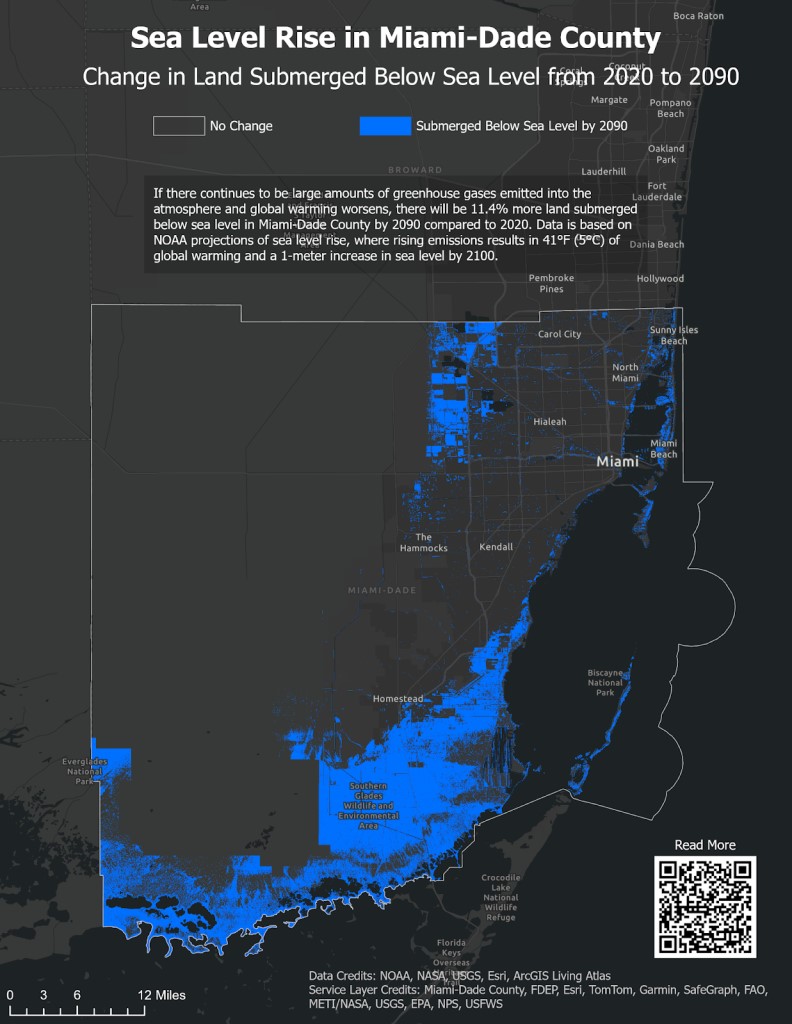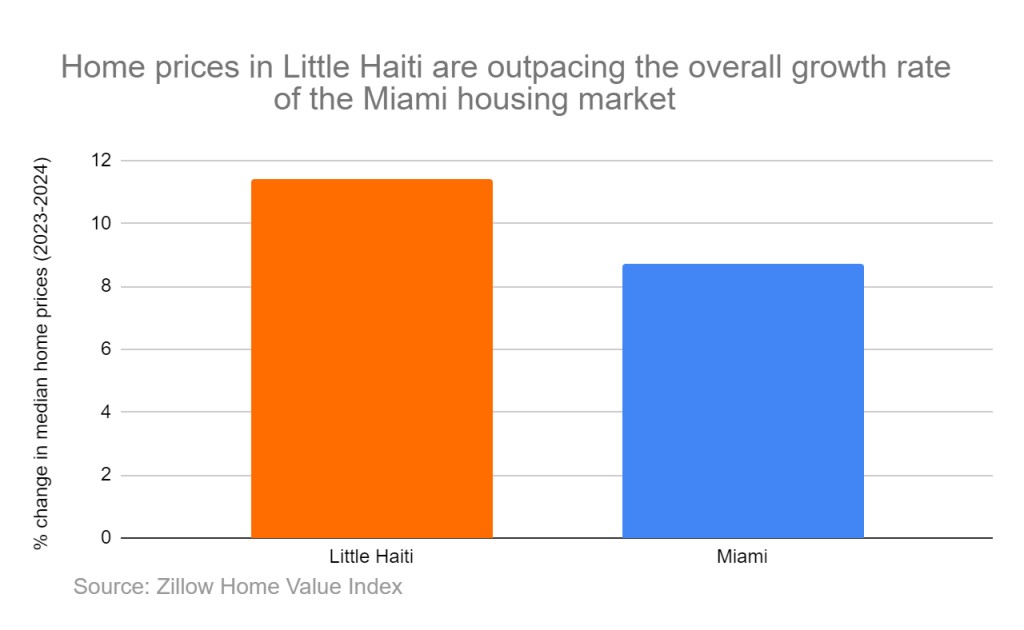By Esmeralda Hechavarria, Caroline Nickerson, Olivia Zhang, Nicole Dan and Libbe Greenberg, Florida Community Innovation
Earlier this year, we – Florida Community Innovation’s students and volunteers – hosted a data walk in Miami about climate gentrification. A data walk is when community members come to an in-person event to discuss data visualizations (graphs, charts and more). Climate gentrification refers to the phenomenon when traditional communities are displaced because of impacts like sea level rise.

After our data walk, we spent the summer researching the topic of climate gentrification and writing up a long blog post about our data visualizations and recommendations for community action. You can read the full publication on FloridaInnovation.org, and see more of the data visualizations there.
One of our University of Florida students, Olivia Zhang, created an interactive digital map of sea-level rise projections in Miami-Dade County, revealing that 11.4% more land will be submerged by 2090. As wealthier residents move inland to escape climate risks, the demand for housing in elevated areas increases, driving gentrification.
Then, Caroline Nickerson, a PhD candidate at the University of Florida and our executive director, used American Community Survey data to show how the percentage of Black residents in Miami’s Little Haiti neighborhood has decreased, while Hispanic residents have increased, reflecting the displacement caused by rising property values.
Her work was complemented by UF student Esmeralda Hechavarria’s analysis, which revealed that home prices in Little Haiti increased by 11.4% in the last year, compared to 8.7% across Miami, further illustrating how climate gentrification accelerates displacement.
Libbe Greenberg, a recent UF grad and FCI fellow, created visualizations showing salary shifts in Miami’s higher and lower-elevated areas. She found that in Little Haiti, households in higher-income brackets have increased, while those in lower-income brackets have declined, indicating that the area is becoming wealthier.

Nicole Dan, another UF grad and the vice president of FCI’s board, analyzed the relationship between property value and flood risk. Her visualization showed that towns with higher elevations still have lower average taxable property values, suggesting that climate gentrification’s full impact has yet to be felt, though it is on the rise.
At the event itself, as we shared our visualizations with community members and facilitated a discussion, the topic of “green” climate gentrification came up — where eco-friendly development raises property values and leads to further displacement of local residents. Attendees at our Data Walk emphasized the need to develop green infrastructure that is inclusive and protects communities from being priced out.
So, what were the results of our summer research deep dive? We have these recommendations:
- Educate yourself and others: Share our blog post on FloridaInnovation.org and other resources on climate gentrification with your network. Some resources about climate gentrification that we recommend sharing include “Climate Gentrification: From Theory to Empiricism in Miami-Dade County, Florida” by Jesse Keenan et al (2018), and the book “Climate Justice: Hope, Resilience, and the Fight for a Sustainable Future” by Mary Robinson.
- Support local initiatives: Donate to or volunteer with organizations that focus on climate justice and affordable housing. Some examples include the Climate Justice Alliance, Right to the City Alliance and the Florida Housing Coalition. Organizations that attended our data walk who would be great to get involved with include the CLEO Institute, the Miami Climate Alliance and Dream in Green.
- Advocate for policy change: Contact your local representatives to support policies that address both climate resilience and housing equity such as the ones mentioned above. If you’re looking for policies to recommend, consider the expansion of green infrastructure in vulnerable communities and anti-displacement protections such as increasing the housing supply.
- Provide us with feedback: If you are a community member impacted by climate gentrification, let us know how we can help! If you are part of a community organization, let us know how we can work together! Leave us a reply on the forum in our FloridaInnovation.org blog post.
We will continue to monitor comments on our blog post to be responsive in regard to this issue. We view our role as student leaders and volunteers to be disseminating information about this issue and uplifting the organizations doing good work.
If you are part of one of those organizations, please leave a comment on the blog post so we can spread the word about you — in our newsletter, on social media and in community meetings.
Have questions or want to get more involved? Contact us via email at in**@***************on.org or follow us on Instagram (@floridacommunityinnovation).
This piece was written by students and volunteers working with Florida Community Innovation (FCI), a civic technology nonprofit. Banner image: Sunny-day flooding in downtown Miami (B137, CC BY-SA 4.0, via Wikimedia Commons).
Sign up for The Invading Sea newsletter by visiting here. If you are interested in submitting an opinion piece to The Invading Sea, email Editor Nathan Crabbe at nc*****@*au.edu.



